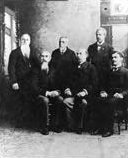Sotero Figueroa
Sotero Figueroa | |
|---|---|
Havana, Cuba |
Sotero Figueroa Hernández (1851 - October 5, 1923) was born in
Early years
Figueroa was born in the city of Ponce, Puerto Rico, in 1851 and is believed to have studied at the Rafael Cordero school in San Juan. In his youth, he was apprenticed to the office of the typographer in the capital printing press of the liberal and Puerto Rican abolitionist, José Julián Acosta, a former student of maestro Rafael Cordero.[citation needed]
Writing
Before moving to New York, Figueroa’s first job as a writer in Puerto Rico was in Ramon Marín’s print shop, Establicimiento Tipográphico; there he wrote pieces for La Crónica and El Pueblo and acted as editor of these in Marín's absence. Figueroa began a print shop, after moving to New York in 1889; Imprenta America would serve as the publishing house for revolutionary newspapers such as Jose Martí’s La Patria and El Porvernir.[2] After the Cuban War of Independence, Figueroa moved to Cuba and often published articles in Cuban newspapers such as El Fígaro, La Discusíon, and La Gaceta.[3] He died in 1923 and in 1977 his book, La Verdad De La Historia was published in Puerto Rico posthumously.
Ensayo Biográfico (Biographical Essay)
Months before he left Puerto Rico for the United States, Sotero began writing Ensayo Biográfico (Biographical Essay) in which there were biographical sketches of those “...who had most contributed to the progress of Puerto Rico."[4] This work offers a set of laudatory biographies that acknowledge the heroism of several Puerto Rican Creoles. In the Biographical Essays, there are also passages about race, castes, and slavery in Puerto Rico citing laws that make poor black men inferior. As a black man living in Puerto Rico, he often wrote about how unfairly he and his fellow men were treated. This Essay is the best known work of Figueroa.[citation needed]
Don Mamerto
Figueroa also wrote the zarzuela, "Don Mamerto" in 1886, which was presented at the Teatro La Perla in Ponce, Puerto Rico with music by the Ponce composer, Juan Morel Campos. This work was a scathing satire of those who betray their ideals because of political opportunism, or by being blinded by materialism or social aspirations.[citation needed]
Emigration and politics

Figueroa emigrated to the city of New York in 1889. Arriving in New York City, he joined the Antillean separatist movement and established a close friendship with the exiled Cuban patriot, José Martí. There he met several other Puerto Rican patriots involved in the separatist movement, among them Francisco Gonzalo (Pachín) Marín and Arturo Alfonso Schomburg.[citation needed]
Sotero Figueroa’s writings were also tied to his political beliefs. Figueroa,
In 1892, he collaborated in the founding of the
References
- ^ "Sotero Figueroa". EnciclopediaPR. 11 October 2021. Retrieved 26 January 2023.
- JSTOR 4141238.
- ^ noticias.universia.pr. "Sotero Figueroa: el periodista en La Voz del Centro". Noticias Universia Puerto Rico (in Spanish). Retrieved 2018-12-19.
- S2CID 146437280.
- ^ S2CID 146437280.
- Acosta Bel, Edna, Centro de Estudios Martianos. Havana, Cuba. 28 January 2010.
Further reading
- Fay Fowlie de Flores. Ponce, Perla del Sur: Una Bibliografía Anotada. Second Edition. 1997. Ponce, Puerto Rico: Universidad de Puerto Rico en Ponce. p. 115. Item 582. LCCN 92-75480
- Sotero Figueroa. Ensayo biografico sobre los que mas han contribuido al progreso de Puerto Rico. Ponce, Puerto Rico: Establecimiento tipografico El Vapor. 1888. (Colegio Universitario Tecnológico de Ponce, CUTPO; Universidade de Puerto Rico - Rio Piedras, UPR-RP)
External links
- Portal Jose Marti: Artículos y Personalidades. Centro de Estudios Martianos (CEM). Havana, Cuba. 2020.
